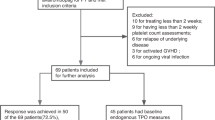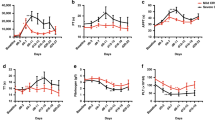Summary:
Antithymocyte globulin (ATG) is increasingly used in pre-allogeneic stem cell transplantation (allo-SCT) conditioning regimens to prevent graft rejection and graft-versus-host disease. However, ATG was also found to be associated with increased incidence of thrombosis during organ transplantation. In the present study, we tested the coagulation status of 21 patients with hematologic malignancies undergoing allo-SCT who received ATG-based (11 patients) or non-ATG-based (10) conditioning treatment. We assessed several thrombophilia markers as well as circulating total and endothelial microparticles (TMP/EMP) and soluble CD40 ligand (CD40L). No significant difference in the mean values of prothrombin time, partial thromboplastin time, fibrinogen, antithrombin, protein C, protein S, thrombin–antithrombin III complex, homocysteine levels, prevalence of genetic thrombophilia markers and levels of EMP, TMP or CD40L was observed between the ATG-treated and ATG-untreated patients, as well as before and after conditioning in each group separately. Platelet counts decreased significantly in ATG-treated patients; however, this decrease was not associated with clinical or laboratory evidence of disseminated intravascular coagulation. No patient developed thromboembolic event or veno-occlusive liver disease. Our results suggest that allo-SCT is not associated with increased hypercoagulability and addition of ATG to conditioning regimen has no significant procoagulant effect.
This is a preview of subscription content, access via your institution
Access options
Subscribe to this journal
Receive 12 print issues and online access
$259.00 per year
only $21.58 per issue
Buy this article
- Purchase on Springer Link
- Instant access to full article PDF
Prices may be subject to local taxes which are calculated during checkout


Similar content being viewed by others
References
Dvorak HF, Nagy JA, Berse B et al. Vascular permeability factor, fibrin, and the pathogenesis of tumor stroma formation. Ann NY Acad Sci USA 1992; 667: 101–111.
Cavanaugh PG, Sloane BF, Honn KV . Role of the coagulation system in tumor-cell induced platelet aggregation and metastasis. Haemostasis 1988; 18: 37–46.
Hoffman R, Haim N, Brenner B . Cancer and thrombosis revisited. Blood Rev 2001; 15: 61–67.
Tempelhoff GF, Dietrich M, Hommel G, Heilmann L . Blood coagulation during adjuvant epirubicine/cyclophosphamide chemotherapy in patients with primary operable breast cancer. J Clin Oncol 1996; 14: 2560–2568.
Sletnes KE, Holte H, Halvorsen S et al. Activation of coagulation and deep vein thrombosis after bone marrow harvesting and insertion of a Hickman-catheter in ABMT patients with malignant lymphoma. Bone Marrow Transplant 1996; 17: 577–581.
Falanga A, Ofosu FA, Delaini F et al. The hypercoagulable state in cancer patients: evidence for impaired thrombin inhibitions. Blood Coagul Fibrinolysis 1994; 1 (Suppl.): S19–S23 discussion 59–64.
Gordon B, Haire W, Kessinger A et al. High frequency of antithrombin 3 and protein C deficiency following autologous bone marrow transplantation for lymphoma. Bone Marrow Transplant 1991; 8: 497–502.
Gordon BG, Saving KL, McCallister JA et al. Cerebral infarction associated with protein C deficiency following allogeneic bone marrow transplantation. Bone Marrow Transplant 1991; 8: 323–325.
Conlan MG, Haire WD, Kessinger A, Armitage JO . Prothrombotic hemostatic abnormalities in patients with refractory malignant lymphoma presenting for autologous stem cell transplantation. Bone Marrow Transplant 1991; 7: 475–479.
Harper PL, Jarvis J, Jennings I et al. Changes in the natural anticoagulants following bone marrow transplantation. Bone Marrow Transplant 1990; 5: 39–42.
Anderson ND, Wood Jr S . Intravascular thrombosis and leukocyte destruction in vivo by heterologous anti-lymphocyte serum. Fed Proc 1970; 29: 145–149.
Mee AD, Evans DB . Anti-lymphocyte-serum preparations in treatment of renal allograft rejection. Lancet 1970; 2: 16–19.
Simmons RL, Condie R, Najarian JS . Antilymphoblast globulin for renal allograft prolongation. Transplant Proc 1972; 4: 487–490.
Kimball DB, Rickles FR, Gockerman JP et al. Procoagulant and platelet aggregating properties of anti lymphocyte sera. J Lab Clin Med 1976; 87: 868–881.
Gruber SA, Pescovitz MD, Simmons RL et al. Thromboembolic complications in renal allograft recipients. Transplantation 1987; 44: 775–778.
Weber M, Kroger N, Langer F et al. Non-overt disseminated intravascular coagulation in patients during treatment with antithymocyte globulin for unrelated allogeneic hematopoietic stem cell transplantation. Bone Marrow Transplant 2003; 31: 817–822.
Hoffman M, Monroe DM, Roberts HR . Coagulation factor IXa binds to activated platelets and platelet-derived microparticles: a flow cytometric study. Thromb Haemost 1992; 68: 74–78.
Barry OP, Practico D, Lawson JA, Fitzgerald GA . Transcellular activation of platelets and endothelial cells by bioactive lipids in platelet microparticles. J Clin Invest 1997; 99: 2118–2127.
Mesri M, Altieri DC . Endothelial cell activation by leukocyte microparticles. J Immunol 1998; 161: 4382–4387.
Galli M, Grassi A, Barbui T . Platelet-derived microvesicles in thrombotic thrombocytopenic purpura and hemolytic uremic syndrome. Thromb Haemost 1996; 75: 427–431.
Mallat Z, Benamer H, Hugel B et al. Elevated levels of' shed membrane microparticles with procoagulant potential in the peripheral circulating blood of patients with acute coronary syndromes. Circulation 2000; 101: 841–848.
Joop K, Berckmans RJ, Nieuwland R et al. Microparticles from patients with multiple organ dysfunction syndrome and sepsis support coagulation through multiple mechanisms. Thromb Haemost 2001; 85: 810–820.
Walenga JM, Jeske WP, Messmore HL . Mechanisms of venous and arterial thrombosis in heparin-induced thrombocytopenia. J Thromb 2000; 10 (Suppl. 1): 13–20.
Hughes M, Hayward CP, Warkentin TE et al. Morphological analysis of microparticle generation in heparin-induced thrombocytopenia. Blood 2000; 96: 188–194.
Greer IA . Thrombosis in pregnancy: maternal and fetal issues. Lancet 1999; 353: 1258–1265.
Buhlmann JE, Noelle RJ . Therapeutic potential for blockade of the CD40 ligand, gp39. J Clin Immunol 1996; 16: 83–89.
Miga A, Masters S, Gonzalez M, Noelle RJ . The role of CD40–CD154 interactions in the regulation of cell mediated immunity. Immunol Invest 2000; 29: 111–114.
Jacobson DW, Gatautis VJ, Green R et al. Rapid HPLC determination of total homocysteine and other thiols in serum and plasma: sex differences and correlation with cobalamin and folate concentrations in healthy subjects. Clin Chem 1994; 40: 873–881.
Salomon O, Steinberg DM, Zivelin A et al. Single and combined prothrombotic factors in patients with idiopathic venous thromboembolism. Arterioscler Thromb Vasc Biol 1999; 19: 511–518.
Frosst P, Blom HJ, Milos R et al. Candidate genetic risk factor for vascular disease: a common mutation in methylenetetrahydrofolate reductase. Nat Genet 1995; 10: 111–113.
Starzl TE, Boehmig HJ, Amemiya H et al. Clotting changes, including disseminated intravascular coagulation, during rapid renal homograft rejection. N Engl J Med 1970; 283: 383–390.
Acknowledgements
This work is supported in part by a research grant from Fresenius (AN, AI, Gmbh Munich, Germany). The sponsor had no role in design, collection, analysis or interpretation of data as well on the decision to submit this paper for publication.
Author information
Authors and Affiliations
Corresponding author
Rights and permissions
About this article
Cite this article
Inbal, A., Lubetsky, A., Shimoni, A. et al. Assessment of the coagulation profile in hemato-oncological patients receiving ATG-based conditioning treatment for allogeneic stem cell transplantation. Bone Marrow Transplant 34, 459–463 (2004). https://doi.org/10.1038/sj.bmt.1704609
Received:
Accepted:
Published:
Issue Date:
DOI: https://doi.org/10.1038/sj.bmt.1704609
Keywords
This article is cited by
-
Risk factors and outcomes of diffuse alveolar haemorrhage after allogeneic haematopoietic stem cell transplantation
Bone Marrow Transplantation (2021)
-
Significance of elevation in cell-derived microparticles after allogeneic stem cell transplantation: transient elevation of platelet-drived microparticles in TMA/TTP
Bone Marrow Transplantation (2005)



